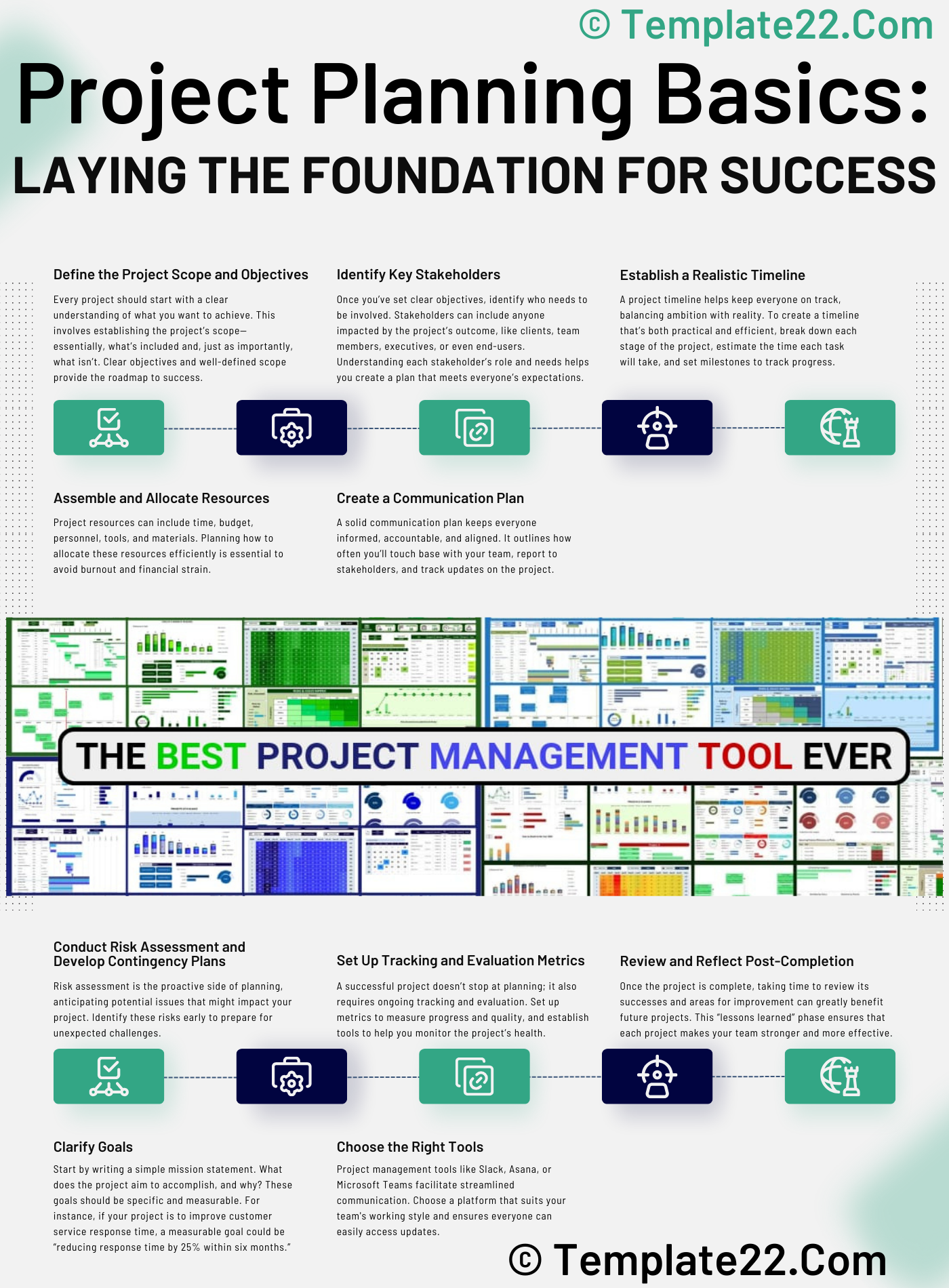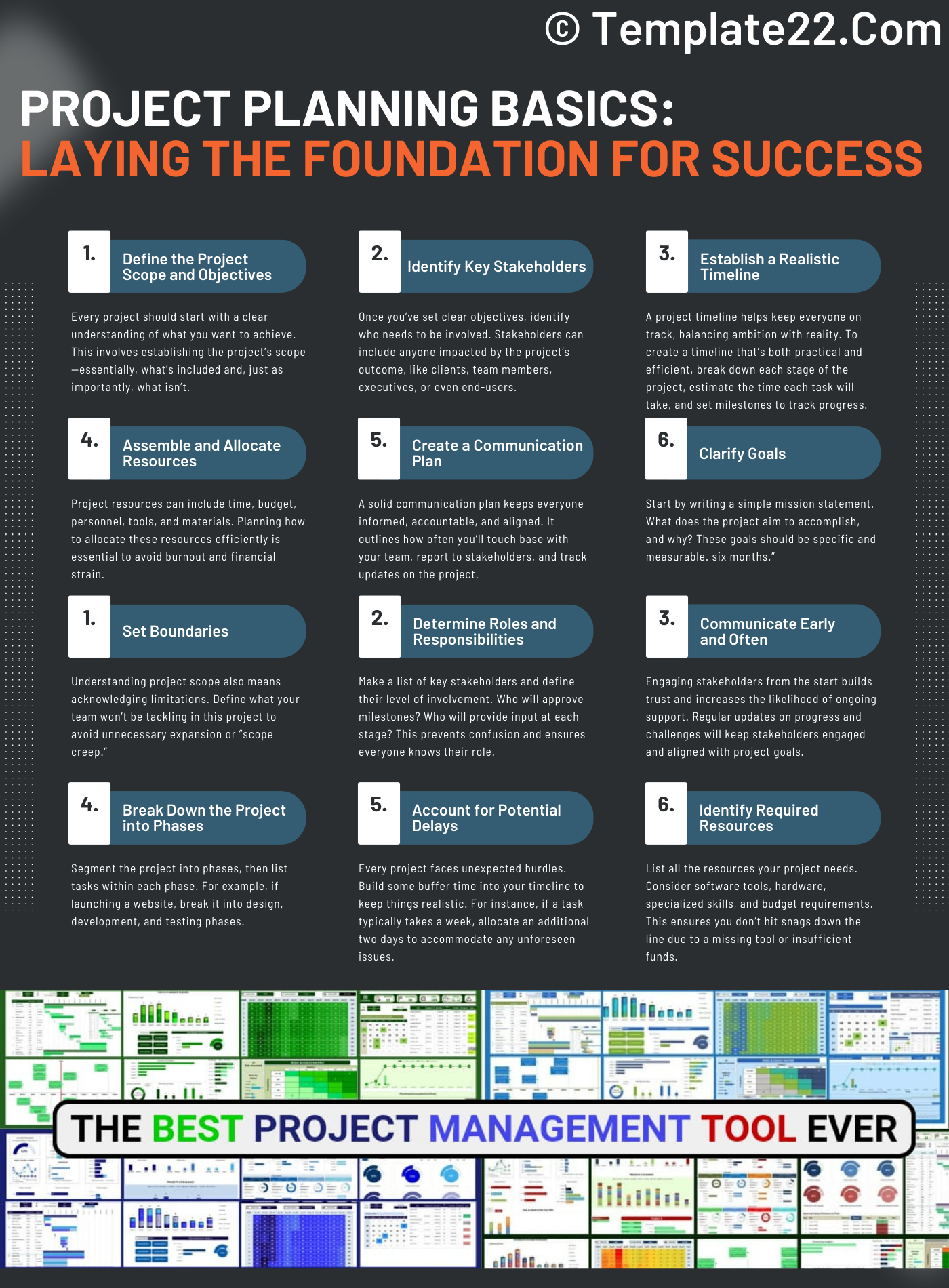 When it comes to successful project management, effective project planning is the bedrock. Without a solid plan, even the most straightforward projects can spiral into confusion and missed deadlines. Let’s dive into the essential steps to set up a project plan that keeps your goals, resources, and team aligned for success.
When it comes to successful project management, effective project planning is the bedrock. Without a solid plan, even the most straightforward projects can spiral into confusion and missed deadlines. Let’s dive into the essential steps to set up a project plan that keeps your goals, resources, and team aligned for success.
1. Define the Project Scope and Objectives
Every project should start with a clear understanding of what you want to achieve. This involves establishing the project’s scope—essentially, what’s included and, just as importantly, what isn’t. Clear objectives and well-defined scope provide the roadmap to success.
- Clarify Goals: Start by writing a simple mission statement. What does the project aim to accomplish, and why? These goals should be specific and measurable. For instance, if your project is to improve customer service response time, a measurable goal could be “reducing response time by 25% within six months.”
- Set Boundaries: Understanding project scope also means acknowledging limitations. Define what your team won’t be tackling in this project to avoid unnecessary expansion or “scope creep.”
2. Identify Key Stakeholders
Once you’ve set clear objectives, identify who needs to be involved. Stakeholders can include anyone impacted by the project’s outcome, like clients, team members, executives, or even end-users. Understanding each stakeholder’s role and needs helps you create a plan that meets everyone’s expectations.
- Determine Roles and Responsibilities: Make a list of key stakeholders and define their level of involvement. Who will approve milestones? Who will provide input at each stage? This prevents confusion and ensures everyone knows their role.
- Communicate Early and Often: Engaging stakeholders from the start builds trust and increases the likelihood of ongoing support. Regular updates on progress and challenges will keep stakeholders engaged and aligned with project goals.
CLICK HERE TO DOWNLOAD 300+ PROJECT MANAGEMENT TEMPLATES & DOCUMENTS IN EXCEL
3. Establish a Realistic Timeline
A project timeline helps keep everyone on track, balancing ambition with reality. To create a timeline that’s both practical and efficient, break down each stage of the project, estimate the time each task will take, and set milestones to track progress.
- Break Down the Project into Phases: Segment the project into phases, then list tasks within each phase. For example, if launching a website, break it into design, development, and testing phases.
- Account for Potential Delays: Every project faces unexpected hurdles. Build some buffer time into your timeline to keep things realistic. For instance, if a task typically takes a week, allocate an additional two days to accommodate any unforeseen issues.
4. Assemble and Allocate Resources
Project resources can include time, budget, personnel, tools, and materials. Planning how to allocate these resources efficiently is essential to avoid burnout and financial strain.
- Identify Required Resources: List all the resources your project needs. Consider software tools, hardware, specialized skills, and budget requirements. This ensures you don’t hit snags down the line due to a missing tool or insufficient funds.
- Assign Team Members to Tasks: Every team member should know what they’re responsible for. Assign tasks according to each person’s skill set and availability. For example, the design phase of a website project would require a UI/UX designer, while the development phase would need a coder.
5. Create a Communication Plan
A solid communication plan keeps everyone informed, accountable, and aligned. It outlines how often you’ll touch base with your team, report to stakeholders, and track updates on the project.
- Choose the Right Tools: Project management tools like Slack, Asana, or Microsoft Teams facilitate streamlined communication. Choose a platform that suits your team’s working style and ensures everyone can easily access updates.
- Set Regular Check-Ins: Schedule regular meetings, whether weekly or bi-weekly, to discuss progress, address concerns, and realign as needed. Clear communication reduces misunderstandings and keeps the project moving smoothly.
6. Conduct Risk Assessment and Develop Contingency Plans
Risk assessment is the proactive side of planning, anticipating potential issues that might impact your project. Identify these risks early to prepare for unexpected challenges.
- Identify Potential Risks: Create a risk matrix listing potential project obstacles, such as budget cuts, delays, or technical issues. Estimate the likelihood and impact of each risk to prioritize where to focus preventive efforts.
- Develop Contingency Plans: A backup plan guides if things don’t go as expected. For instance, if you anticipate delays in a task, have an alternative action plan, like reallocating team members or adjusting deadlines.
7. Set Up Tracking and Evaluation Metrics
A successful project doesn’t stop at planning; it also requires ongoing tracking and evaluation. Set up metrics to measure progress and quality, and establish tools to help you monitor the project’s health.
- Define Key Performance Indicators (KPIs): KPIs help you evaluate whether the project is on track. These can include metrics like time taken, budget spent, quality of output, and customer satisfaction.
- Use Tracking Tools: Tools like Trello, Jira, or Excel sheets can help you monitor progress in real time. Regularly update these tools to keep everyone informed on the project’s status and any adjustments to timelines or resources.
CLICK HERE TO DOWNLOAD 300+ PROJECT MANAGEMENT TEMPLATES & DOCUMENTS IN EXCEL
8. Review and Reflect Post-Completion
Once the project is complete, taking time to review its successes and areas for improvement can greatly benefit future projects. This “lessons learned” phase ensures that each project makes your team stronger and more effective.
- Conduct a Team Debrief: Gather your team to discuss what went well and what could have been improved. This open discussion fosters a culture of continuous improvement and celebrates accomplishments.
- Document Takeaways: Record any insights or best practices that emerged. Was there a communication strategy that particularly helped? A tool that proved essential? Document these for reference and share them with other teams if applicable.
Final Thoughts
Effective project planning is a step-by-step process that aligns objectives, resources, and people. By following these project planning basics—defining scope, engaging stakeholders, setting timelines, managing resources, communicating, assessing risks, and tracking progress—you set your team up for success and adaptability. Whether you’re handling a small internal project or a large client assignment, a well-thought-out plan not only improves project outcomes but also builds a stronger, more resilient team.



